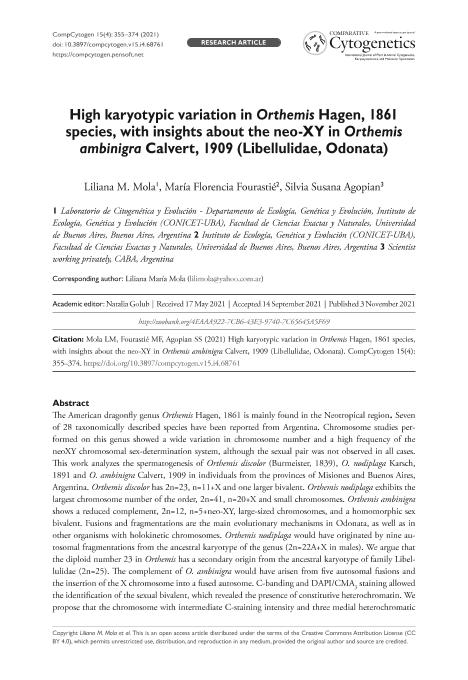Artículo
High karyotypic variation in Orthemis Hagen, 1861 species, with insights about the neo-XY in Orthemis ambinigra Calvert, 1909 (Libellulidae, Odonata)
Fecha de publicación:
05/2021
Editorial:
Zoological Institute
Revista:
Comparative Cytogenetics
ISSN:
1993-0771
e-ISSN:
1993-078X
Idioma:
Inglés
Tipo de recurso:
Artículo publicado
Clasificación temática:
Resumen
The American dragonfly genus Orthemis Hagen, 1861 is mainly found in the Neotropical region. Seven of 28 taxonomically described species have been reported from Argentina. Chromosome studies performed on this genus showed a wide variation in chromosome number and a high frequency of the neoXY chromosomal sex-determination system, although the sexual pair was not observed in all cases. This work analyzes the spermatogenesis of Orthemis discolor (Burmeister, 1839), O. nodiplaga Karsch, 1891 and O. ambinigra Calvert, 1909 in individuals from the provinces of Misiones and Buenos Aires, Argentina. Orthemis discolor has 2n=23, n=11+X and one larger bivalent. Orthemis nodiplaga exhibits the largest chromosome number of the order, 2n=41, n=20+X and small chromosomes. Orthemis ambinigra shows a reduced complement, 2n=12, n=5+neo-XY, large-sized chromosomes, and a homomorphic sex bivalent. Fusions and fragmentations are the main evolutionary mechanisms in Odonata, as well as in other organisms with holokinetic chromosomes. Orthemis nodiplaga would have originated by nine autosomal fragmentations from the ancestral karyotype of the genus (2n=22A+X in males). We argue that the diploid number 23 in Orthemis has a secondary origin from the ancestral karyotype of family Libellulidae (2n=25). The complement of O. ambinigra would have arisen from five autosomal fusions and the insertion of the X chromosome into a fused autosome. C-banding and DAPI/CMA3 staining allowed the identification of the sexual bivalent, which revealed the presence of constitutive heterochromatin. We propose that the chromosome with intermediate C-staining intensity and three medial heterochromatic regions corresponds to the neo-Y and that the neo-system of this species has an ancient evolutionary origin. Moreover, we discuss on the mechanisms involved in the karyotypic evolution of this genus, the characteristics of the neo sex-determining systems and the patterns of heterochromatin distribution, quantity and base pair richness.
Archivos asociados
Licencia
Identificadores
Colecciones
Articulos(IEGEBA)
Articulos de INSTITUTO DE ECOLOGIA, GENETICA Y EVOLUCION DE BS. AS
Articulos de INSTITUTO DE ECOLOGIA, GENETICA Y EVOLUCION DE BS. AS
Citación
Mola, Liliana Maria; Fourastié, María Florencia; Agopian, Silvia Susana; High karyotypic variation in Orthemis Hagen, 1861 species, with insights about the neo-XY in Orthemis ambinigra Calvert, 1909 (Libellulidae, Odonata); Zoological Institute; Comparative Cytogenetics; 15; 4; 5-2021; 355-374
Compartir
Altmétricas




